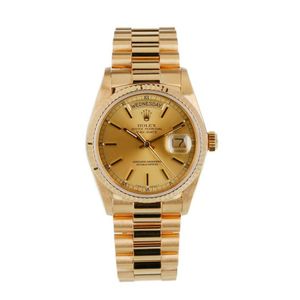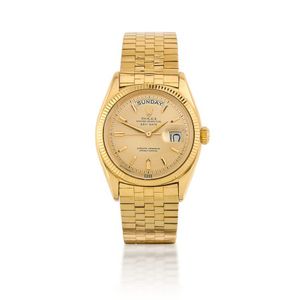18ct Gold Rolex Oyster Perpetual Wristwatch with Day and Date
You must be a subscriber, and be logged in to view price and dealer details.
Subscribe Now to view actual auction price for this item
When you subscribe, you have the option of setting the currency in which to display prices to $Au, $US, $NZ or Stg.
- Date Aperture - A date aperture is a cut out section in the face of a watch or clock, displaying the day of the month.
- Baton Numerals - A watch that instead of displaying numerals on the face, displays a marker in the form of a baton, or lower case letter "L". Since the baton-like marks are not numerals, the feature is also called baton markers, baton indexes and baton indicators.
- Movement - The technical name for the workings of a clock or watch, and does not include the dial or case.
- Gilding - Gilding is a method of ornamentation whereby a thin sheet of gold metal is applied to items made of wood, leather, ceramics, glass and silver for decorative purposes.
For furniture including mirrors, the sheet of gold is usually applied over a coating of gesso. Gesso is a mixture of plaster of Paris and gypsum mixed with water and then applied to the carved wooden frames of mirrors and picture frames as a base for applying the gold leaf. After numerous coats of gesso have been applied, allowed to dry and then sanded a coat of "bole", a usually red coloured mixture of clay and glue is brushed on and allowed to dry, after which the gold leaf is applied. Over time parts of the gilding will rub off so the base colour can be seen. In water gilding, this was generally a blue colour, while in oil gilding, the under layer was often yellow. In Victorian times, gilders frequently used red as a pigment beneath the gold leaf.
Metal was often gilded by a process known as fire gilding. Gold mixed with mercury was applied and heated, causing the mercury to evaporate, the long-term effect of which was to kill or disable the craftsman or woman from mercury poisoning. The pursuit of beauty has claimed many victims, not the least of which were the artists who made those pieces so highly sought after today.
This item has been included into following indexes:
Visually similar items

A ladies Baume & Mercier Rivieria diamond wristwatch, quartz movement, circular white dial with gold Roman numerals and date aperture at three, signed case dial and movement, lock down Crown, gold and stainless steel case and bracelet bands, 22 mm diameter

Rolex, gold President day-date wristwatch, Ref. 118238, case Y962689, c. 2010, automatic movement with officially certified chronometer, fully jewelled, 18ct yellow gold, champagne dial with gold baton indexes, apertures for day and date, centre seconds ha

Rolex, a fine 18ct gold automatic wristwatch with day date and bracelet ref 1803 day-date mid 1960s, Cal. 1555 automatic winding movement, 25 jewels, champagne dial, applied faceted baton indexes, dauphine hands, aperture for day in English at 12, magnifie

Rolex, gold and diamond-set President day-date wristwatch, Ref. 18238, case W810709, c. 1996, automatic movement with officially certified chronometer, fully jewelled, 18ct gold, with reeded gold bezel, champagne dial with diamond set indexes, 'One Way' ra
